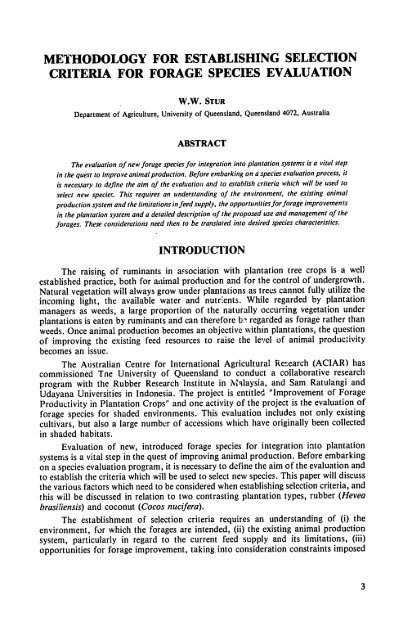Proceedings of a workshop on research methodologies Medan ...
Proceedings of a workshop on research methodologies Medan ...
Proceedings of a workshop on research methodologies Medan ...
You also want an ePaper? Increase the reach of your titles
YUMPU automatically turns print PDFs into web optimized ePapers that Google loves.
METHODOLOGY FOR ESTABLISHING SELECTION<br />
CRITERIA FOR FORAGE SPECIES EVALUATION<br />
W.W. STUR<br />
Department <str<strong>on</strong>g>of</str<strong>on</strong>g> Agriculture, University <str<strong>on</strong>g>of</str<strong>on</strong>g> Queensland, Queensland 4072, Australia<br />
ABSTRACT<br />
The evaluati<strong>on</strong> <str<strong>on</strong>g>of</str<strong>on</strong>g> new forage species for integrati<strong>on</strong> into plantati<strong>on</strong> systems is a vital step<br />
in the quest to improve animal producti<strong>on</strong>. Before embarking <strong>on</strong> a species evaluati<strong>on</strong> process, it<br />
is necessary to define the aim <str<strong>on</strong>g>of</str<strong>on</strong>g> the evaluati<strong>on</strong> and to establish criteria which will be used to<br />
select new species. This requires an understanding <str<strong>on</strong>g>of</str<strong>on</strong>g> the envir<strong>on</strong>ment, the existing animal<br />
producti<strong>on</strong> system and the limitati<strong>on</strong>s infeed supply, the opportunities forforage improvements<br />
in the plantati<strong>on</strong> system and a detailed descripti<strong>on</strong> <str<strong>on</strong>g>of</str<strong>on</strong>g> the proposed use and management <str<strong>on</strong>g>of</str<strong>on</strong>g> the<br />
forages. These c<strong>on</strong>siderati<strong>on</strong>s need then to be translated into desired species characteristics.<br />
INTRODUCTION<br />
The raising <str<strong>on</strong>g>of</str<strong>on</strong>g> ruminants in associati<strong>on</strong> with plantati<strong>on</strong> tree crops is a well<br />
established practice, both for aniimal producti<strong>on</strong> and for the c<strong>on</strong>trol <str<strong>on</strong>g>of</str<strong>on</strong>g> undergrowth.<br />
Natural vegetati<strong>on</strong> will always grow under plantati<strong>on</strong>s as trees cannot fully utilize the<br />
incoming light, the available water and nutri,ents. While regarded by plantati<strong>on</strong><br />
managers as weeds, a large proporti<strong>on</strong> <str<strong>on</strong>g>of</str<strong>on</strong>g> the naturally occurring vegetati<strong>on</strong> under<br />
plantati<strong>on</strong>s is eaten by ruminants and can therefore b: regarded as forage rather than<br />
weeds. Once animal producti<strong>on</strong> becomes an objective within plantati<strong>on</strong>s, the questi<strong>on</strong><br />
<str<strong>on</strong>g>of</str<strong>on</strong>g> improving the existing feed resources to raise the level <str<strong>on</strong>g>of</str<strong>on</strong>g> animal productivity<br />
becomes an issue.<br />
The Australian Centre for Internati<strong>on</strong>al Agricultural Research (ACIAR) has<br />
commissi<strong>on</strong>ed Tne University <str<strong>on</strong>g>of</str<strong>on</strong>g> Queensland to c<strong>on</strong>duct a collaborative <strong>research</strong><br />
program with the Rubber Research Institute in iialaysia, and Sam Ratulangi and<br />
Udayana Universities in Ind<strong>on</strong>esia. The project is entitled "Improvement <str<strong>on</strong>g>of</str<strong>on</strong>g> Forage<br />
Productivity in Plantati<strong>on</strong> Crops" and <strong>on</strong>e activity <str<strong>on</strong>g>of</str<strong>on</strong>g> the project is the evaluati<strong>on</strong> <str<strong>on</strong>g>of</str<strong>on</strong>g><br />
forage species for shaded envir<strong>on</strong>ments. This evaluati<strong>on</strong> includes not <strong>on</strong>ly existing<br />
cultivars, but also a large number <str<strong>on</strong>g>of</str<strong>on</strong>g> accessi<strong>on</strong>s which have originally been collected<br />
in shaded habitats.<br />
Evaluati<strong>on</strong> <str<strong>on</strong>g>of</str<strong>on</strong>g> new, introduced forage species for integrati<strong>on</strong> into plantati<strong>on</strong><br />
systems is a vital step in the quest <str<strong>on</strong>g>of</str<strong>on</strong>g> improving animal producti<strong>on</strong>. Before embarking<br />
<strong>on</strong> a species evaluati<strong>on</strong> program, it is necessary to define the aim <str<strong>on</strong>g>of</str<strong>on</strong>g> the evaluati<strong>on</strong> and<br />
to establish the criteria which will be used to select new species. This paper will discuss<br />
the various factors which need to be c<strong>on</strong>sidered when establishing selecti<strong>on</strong> criteria, and<br />
this will be discussed in relati<strong>on</strong> to two c<strong>on</strong>trasting plantati<strong>on</strong> types, rubber (Hevea<br />
brasiliensis) and coc<strong>on</strong>ut (Cocos nucifera).<br />
The establishment <str<strong>on</strong>g>of</str<strong>on</strong>g> selecti<strong>on</strong> criteria requires an understanding <str<strong>on</strong>g>of</str<strong>on</strong>g> (i) the<br />
envir<strong>on</strong>ment, for which the forages are intended, (ii) the existing animal producti<strong>on</strong><br />
system, particularly in regard to the current feed supply and its limitati<strong>on</strong>s, (iii)<br />
opportunities for forage improvement, taking into c<strong>on</strong>siderati<strong>on</strong> c<strong>on</strong>straints imposed<br />
3

















